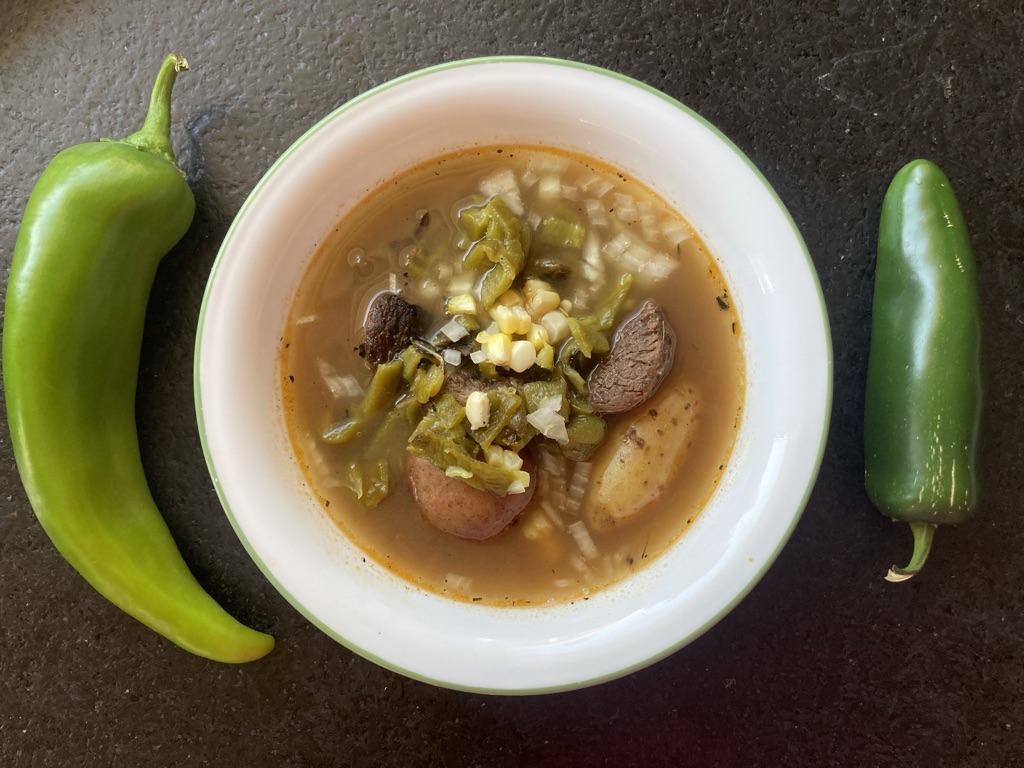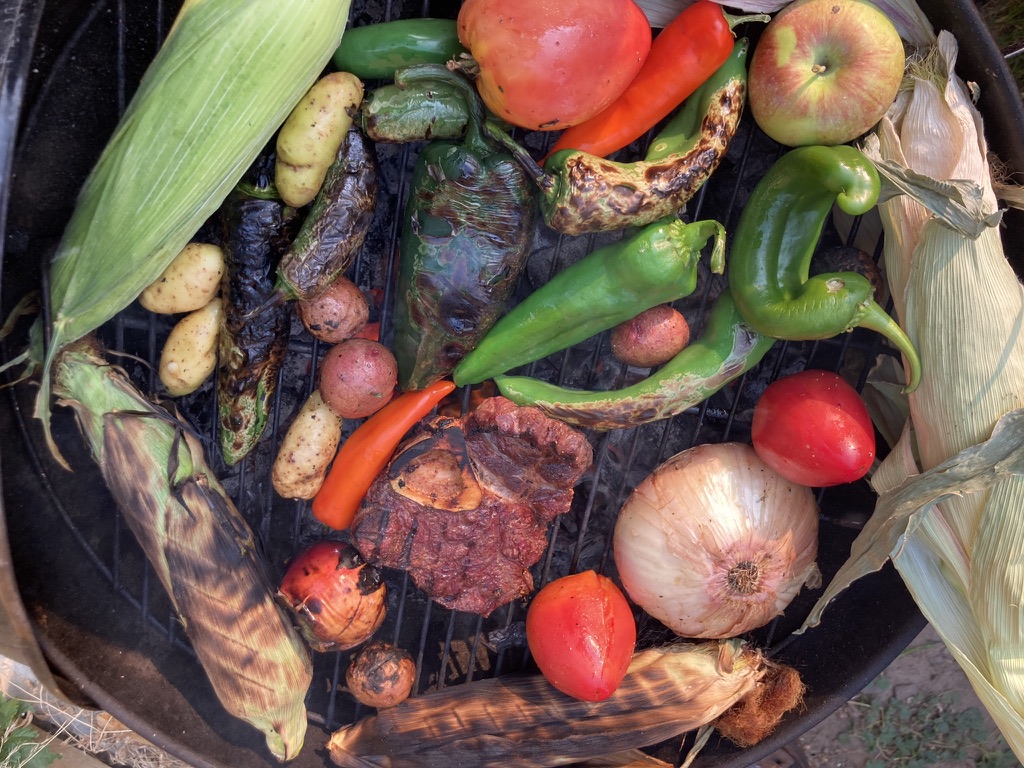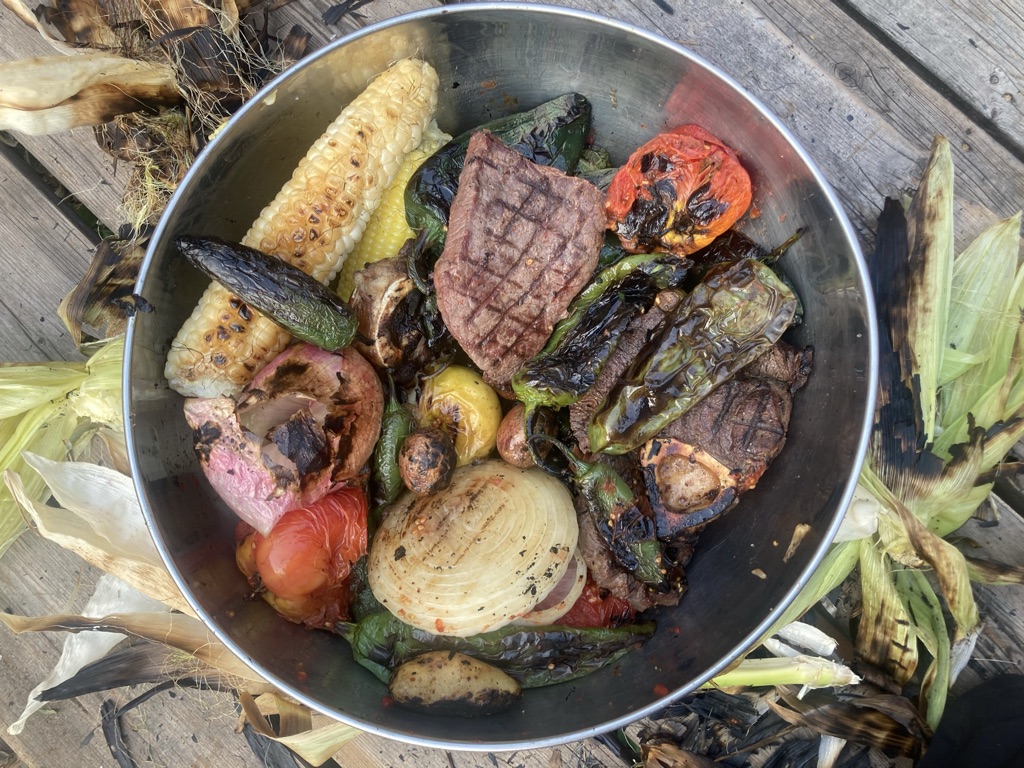


Grilled Green Chile Stew
After seven enchanting years in New Mexico, I became part native. Especially my stomach. Early fall was my favorite time, in part because the end of another hot summer always brought a sweet relief, but mostly because of a certain aroma that wafted up and down the Rio Grande Valley this time of year. The large-scale roasting of green chile fills the air with a magic pungency that grounds you to that arid landscape like autumn foliage and cider do in New England.
Green chile has transformational powers on food. It can turn a cheeseburger into a green chile cheeseburger, or scrambled eggs into green chile scrambled eggs. This simple modification sounds elementary, but results in a quantum leap in flavor.
And then there is green chile the main course. This stew is not to be confused with “chili,” the midwestern concoction that resembles a Sloppy Joe with beans that somehow found its way to Texas. A New Mexico green chile stew is brothy and nuanced, like the evening breeze after a monsoon rain.
But while roasted green chile peppers, and the delicious foods they elevate, are central to its identity, New Mexico hardly has a monopoly on growing, roasting and preparing green chile. There is nothing about the local soil or the rain or anything else that makes New Mexico green chile intrinsically better than green chile grown in New Jersey.
The key difference is that a farmer will get a better yield in Hatch, NM then Duluth, MN. But the most important thing — more important than where it was grown or what variety — is simply that the chile be harvested at the proper time. Otherwise, the flavor will be off.
Green chile is, by definition, an unripe chile. Left to their own devices, each pepper on earth will eventually turn red, just like every maple leaf. The trick is to harvest the chile just before it starts to turn red. Since they are all green until that point, the only way to tell if the chile are ready to harvest is by tasting. Alas, most farmers outside of New Mexico don’t seem to know what a green chile tastes like.
If it has splotches of yellow or red, that’s fine. In fact they have a word in New Mexico for when you mix red and green chile together. They call it “Christmas.”
When I put green chile on the grill, it’s for one of three reasons. Roasted green chile freezes really well — a lot better than fresh peppers. In addition to the freezer bag, roasted green chile are additionally protected by a skin that slips right off when you are ready to use it.
Another reason to have green chile on the grill is because there is also meat on the grill, and green chile is like a fine wine when it comes to bringing out the flavor of meat.
The final reason to have green chile on the grill is to make a pot of green chile. And when I do that, I put the other ingredients on the grill as well, including tomatoes, potatoes, onions, corn and meat. After they develop their best selves atop the flaming coals, I put the ingredients in a pot and make chile.
Grill-y Green Chile
Cool weather of fall is a great time to gather around a warm grill, have a cookout, and make an amazing autumn stew from the leftovers. Don’t add herbs, either as a garnish or in cooking. No oregano, no cilantro. The green chile fills that niche.
Serves 10
½ cup liquid aminos or soy sauce (In Mexico they use Maggi)
½ cup olive oil
1 teaspoon salt
1 teaspoon pepper
4 cloves garlic, chopped
1 pounds onions, sliced in half along the equators
2 pounds tomatoes
2-3 pounds meat on the bone, like shank
3 pounds green chile – I like a mix of Anaheim and jalapenos
1 pounds potatoes
3 ears corn, unshucked
2 apples
Chopped onions for garnish
First, make the marinade from the liquid aminos, olive oil, garlic, salt and pepper. Add the potatoes, onions, tomatoes and meat to the marinade and set aside.
Get the grill hot. I use hardwood briquets which burn quickly and add a smokey, exciting note of urgency to the process.
Place the corn cobs along the perimeter of the grill, and roast the chile on the hot middle, turning them as soon as they blister. Keep an eye on the slow cooking corn on the edge, turning as necessary. When the chile are blistered but not charred all around, remove them from the grill and place them in the pot with the marinade, and cover with a tight fitting lid. This step, called “sweating,” allows the green chile flavor to fully develop and makes the peels come off easier.
Add the tomatoes, potatoes, onions and meat to the grill (or do it all at once if your grill is big enough or your batch size is small enough). Don’t let anything burn, but let it brown and get covered in grill marks. You don’t need to worry about cooking anything all the way done. As it’s grilled, add everything — including the shucked corn — back to the marinade along with the chile and cover, so all of the ingredients sweat together.
I use a pot with a perforated insert, like you’d use to make pasta. Cut the meat off the bones and into bite-sized chunks. Cut the corn off the cobs. Add this meat and the potatoes to the bottom of the pot. Then add the insert, and fill it with the bones, tomatoes, apples, onions and corn cobs. Add the remaining marinade, and bring to a simmer. Cook until the meat is tender. While it cooks, peel, seed and chop the roasted green chile.
Remove the insert, leaving a brothy soup with chunks of meat and potatoes. Serve in bowls, garnished with green chile, corn and chopped onions.
#